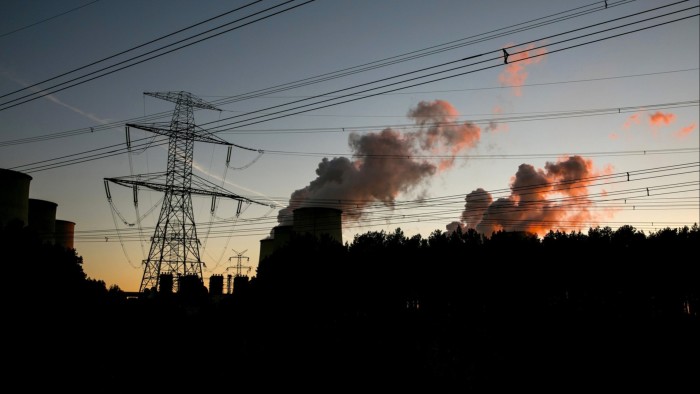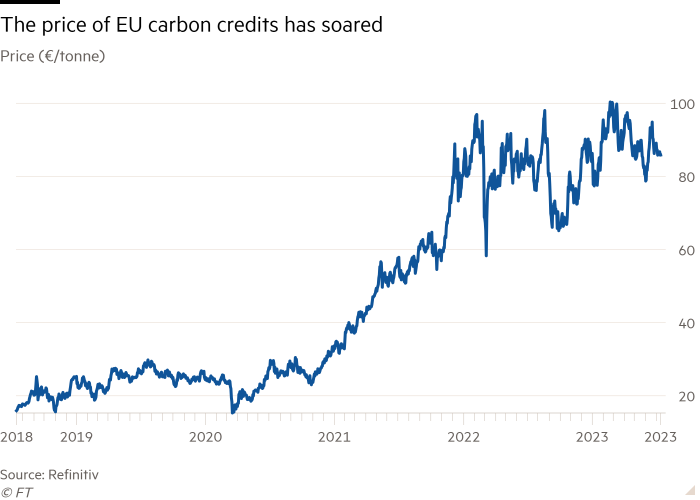Hedge fund manager who cashed in on EU carbon credit rally bets prices will tumble

Roula Khalaf, Editor of the FT, selects her favourite stories in this weekly newsletter.
The price of carbon permits is set to tumble as Europe weans itself off dirty fuels, according to a hedge fund manager who was once one of the market’s biggest bulls.
Per Lekander, who profited handsomely from calling the 2018 rally in carbon prices, told the Financial Times that he was now betting on the market falling sharply in the coming months as the price of natural gas and coal fall.
The price of carbon permits, which are also known as emissions certificates and give energy companies a licence to pollute, hit an all-time high of €100 a tonne in February, helped by an increase in coal use as Russia slashed gas exports to Europe. But Lekander thinks Europe’s energy crisis has spurred a faster than anticipated shift to cleaner energy sources that will hit consumption of fossil fuels, meaning lower demand for carbon credits.
“Europe has been amazing at lowering emissions,” said Lekander, managing partner of energy investing group Clean Energy Transition, which has $2.6bn in assets, and previously a portfolio manager at London-based investment firm Lansdowne Partners. “I see coal and gas prices falling, and I think they are going to go way lower in the longer term. And the emissions market is going to collapse.”
EU carbon credits trade at about €86, up 430 per cent from just five years ago. Lekander said he would close out his short position if prices reached €60. Companies operating in the EU in sectors such as gas, coal power generation or industrial manufacturing are obliged to buy carbon credits.
The total value of EU carbon credits traded last year was €751bn, according to data provider Refinitiv.

As Europe provided financial and military support to Ukraine following Moscow’s full-scale invasion last year, Russia cut natural gas supplies to Europe. Lekander said the urgent need to find new energy sources had boosted use of renewables.
Wind and solar generation provided 22.3 per cent of the EU’s electricity needs last year, overtaking gas for the first time, according to think-tank Ember.
Abundant EU gas storage should also avoid the need to further use coal during the coming winter, Lekander believed.
European gas storage facilities, which are crucial in helping meet higher demand in the winter months, are 80 per cent full — well ahead of the normal level for this time of year.
Gas prices have tumbled over the past year as Europe’s energy crisis eased, though they are still at the higher end of the pre-crisis range. Cheaper gas means there is less incentive to use coal to generate electricity, which emits more than double the amount of carbon dioxide per megawatt hour compared with natural gas.
“Europe is going to fill its gas storage in the second half of August,” said Lekander. “The gas price will go to trash, and if the gas price is trash, the coal price will be trash.”
Lekander’s $1.8bn hedge fund makes bets on the shares of global energy companies, and can also invest in commodities. Last year a wager on rising oil prices helped it gain 20 per cent, he said.
Lekander’s bet on a green energy future is not just limited to carbon permits. He is also betting on publicly listed green energy companies to outperform, and on non-renewable energy groups to suffer in the coming months and years.
US companies in particular have attracted Lekander’s attention after the Inflation Reduction Act, which was passed last year, committed to $369bn in subsidies and investment for renewable energy-related projects over the next 10 years.
Climate Capital

Where climate change meets business, markets and politics. Explore the FT’s coverage here.
Are you curious about the FT’s environmental sustainability commitments? Find out more about our science-based targets here
Comments